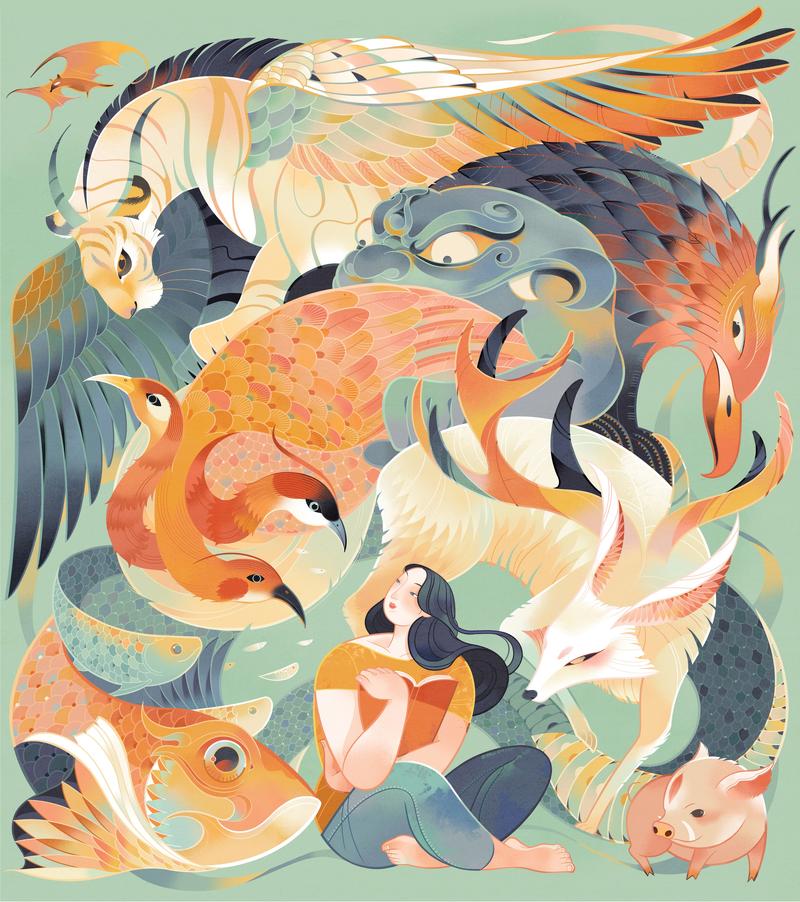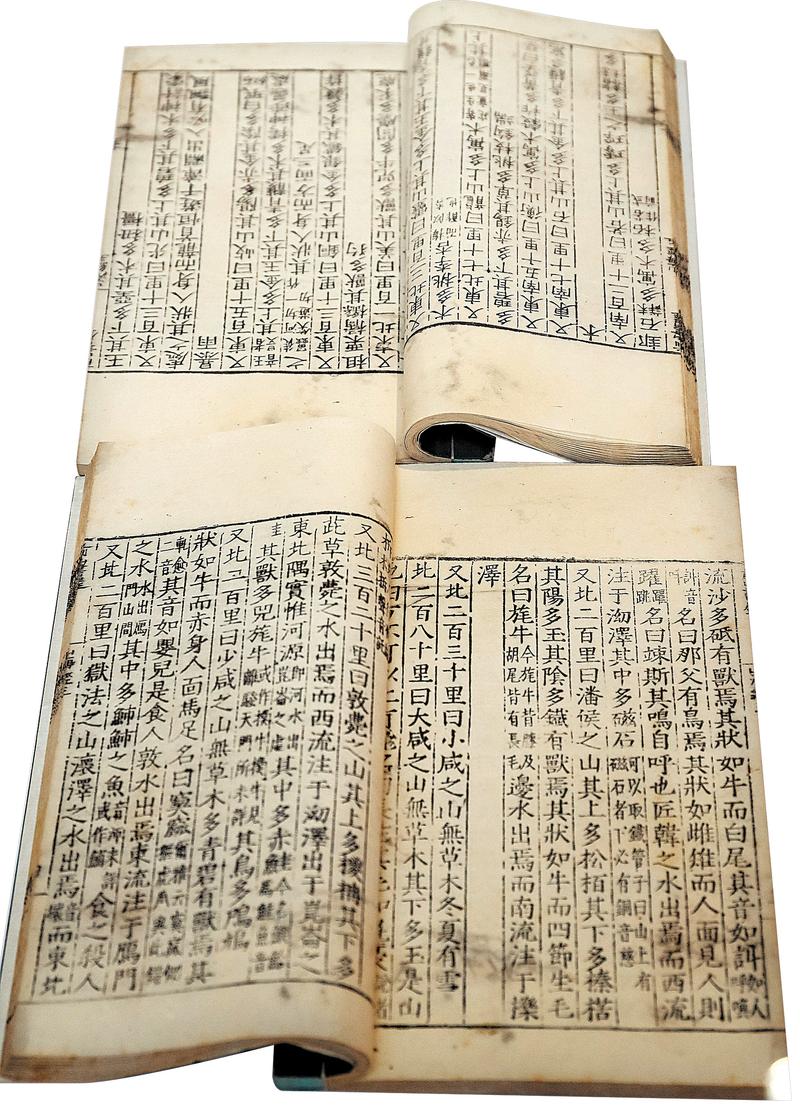Ancient text featuring myths influences creators of popular web content, TV series, video games
 (SONG CHEN / CHINA DAILY)
(SONG CHEN / CHINA DAILY)
Chang’e, China’s lunar probe, is named after a legendary goddess in ancient fairy tales, but few people know that she first appeared in the book Shan Hai Jing, or The Classic of Mountains and Seas, which is thought to have been written during the late Warring States Period (475-221 BC).
The goddess, the epitome of beauty, lived on the moon with her pet rabbit.
Another debutant in the book was Zouwu, a five-colored mythical creature that features in the movie series Fantastic Beasts, directed by David Yates.
Shan Hai Jing, a compilation of mythic geography and beasts, took shape before the Qin Dynasty (221-206 BC), which built China’s first empire. An encyclopedic account of people’s views of the world at that time, the 30,000-word book documents some 40 states, 550 mountains, 300 waterways, more than 100 historical figures and 400 mythical monsters.
The work — and others featuring ancient myths and monsters — have inspired artists and authors throughout history. In recent years, it has also become a source of inspiration for pop culture, cross-cultural exchanges and comparative studies.
Liu Zongdi, professor at the College of Humanities and director of the Institute of Cultural History at Beijing Language and Culture University, has studied Shan Hai Jing, comparing it with The Histories by the ancient Greek historian Herodotus.
The Histories documented geography, people, natural resources, different customs, birds and animals. “In particular, some of the eastern monsters described by Herodotus are quite similar to those in Shan Hai Jing,” Liu said.
He added that in some European maps from the Middle Ages, areas close to India were often painted with monsters, the equivalents of which can be found in Shan Hai Jing.
“I wonder whether in ancient Greece during the Middle Ages, knowledge of Shan Hai Jing was spread through trade exchanges with the Western world. This is an interesting academic topic,” Liu said.
 The exhibition Imaginary Encounter-Divine Comedy Dialogue with Shan Hai Jing was staged in Shanghai from November to February. (PHOTO PROVIDED TO CHINA DAILY)
The exhibition Imaginary Encounter-Divine Comedy Dialogue with Shan Hai Jing was staged in Shanghai from November to February. (PHOTO PROVIDED TO CHINA DAILY)
According to studies, copies of Shan Hai Jing were taken to Japan during the Sui (581-618) and Tang (618-907) dynasties, or much earlier. In Japan, the work was popular as a geographical chronicle of China’s mountains and rivers, and was once regarded as a guidebook for traveling in China. The book’s monsters were also popular because of mysticism among Japanese folklore at the time.
Liu said that many types of mythical monsters in Japan derive from Shan Hai Jing. They include the nine-tailed fox, known for its silver-white fur and nine tails, and which according to folklore can transform into any human form.
“Although I do not agree with simply defining Shan Hai Jing as a book of monsters, it does catalogue a large number of strange birds and monsters, and has had a profound impact on the culture surrounding mystery worldwide,” Liu said.
An exhibition titled Imaginary Encounter — Divine Comedy Dialogue with Shan Hai Jing was staged in Shanghai at the Pearl Art Museum from November to February. An online version of the display is still available, including a 360-degree virtual reality exhibition hall and a video of the curator’s guide to visitors. The online display has been viewed about 200,000 times.
The museum exhibition was supported by the Cultural Office of the Italian Consulate General in Shanghai to mark the 700th anniversary of the death of the poet and scholar Dante Alighieri, known as the “father of the Italian language”.
The exhibits included four precious manuscripts of Dante’s Divine Comedy from the 14th century and two rare engraved copies of Shan Hai Jing from the Shanghai Library. The exhibition also showcased more than 70 multimedia works from five Italian artists and seven artists from China, based on the two classics.
 Volume 18 of Shan Hai Jing. (PHOTO PROVIDED TO CHINA DAILY)
Volume 18 of Shan Hai Jing. (PHOTO PROVIDED TO CHINA DAILY)
Francesco D’Arelli, director of the cultural section at the Italian Consulate General, said: “Both Divine Comedy and The Classic of Mountains and Seas are great classics, in which imagination is the main source of inspiration and even creation. In both works, there is a common experience of journeying between myth and reality.
“Shan Hai Jing was written no later than the 1st century BC. China and Italy were already communicating by that time during the Han Dynasty (206 BC-AD 220) and the Roman Empire. This communication went on for centuries, right up to the time of Dante and Marco Polo.
“Marco Polo came to China, and Dante wrote many works in Italy, laying the foundation for the Italian language. We wanted to highlight this ancient friendship in this exhibition, because it is the foundation of every communication experience.”
Li Dandan, director of the Pearl Art Museum and the exhibition’s chief curator, said, “The display attempted to activate ancient texts with visual art, and construct a colorful dialogue between ancient Chinese and European civilizations in the new era.”
The exhibition attracted numerous visitors from the film and television animation industries seeking to gain more inspiration from imaginative ancient classics, according to Wang Yingyou, a staff member at the museum. She added that the event also increased sales of related books at the museum’s bookstore.
Wu Xinyi, who has a doctorate in literature from Fudan University in Shanghai, said contemporary artworks displayed at the museum show the continuity of Chinese culture and aesthetics, from ancient times to the present.
Qiu Anxiong, whose engravings were exhibited at the museum, said Shan Hai Jing has been a source of inspiration for contemporary artists. His works portray in a humorous way the products of modern industrial civilization, such as airplanes, automobiles and computers, among other things, from the perspective of ancient people, using the graphic style of Shan Hai Jing.
“One of the side effects of modern life is that humans gradually lose their curiosity — falling into intellectual inertia, but when you stop being surprised about the world, the world actually shrinks,” Qiu said. “We should be inspired by Shan Hai Jing when we view the world in front of us.”
Liu Siliang, a lecturer at Shanghai Jiao Tong University’s School of Humanities and a researcher at the university’s Institute of Mythology, said the fairy tales in Shan Hai Jing had a profound influence on the creation of classic Chinese supernatural literature such as Journey to the West and Strange Tales from a Chinese Studio.
 Eddie Redmayne, who appears in Fantastic Beasts: The Crimes of Grindelwald, poses with a picture of Zouwu. (PHOTO PROVIDED TO CHINA DAILY)
Eddie Redmayne, who appears in Fantastic Beasts: The Crimes of Grindelwald, poses with a picture of Zouwu. (PHOTO PROVIDED TO CHINA DAILY)
Popular online literature, TV series and video games, including Chinese Paladin: Sword and Fairy and Legends of Swords, which are hugely popular in China and overseas, also borrow concepts from Shan Hai Jing, Liu Siliang added.
The “star” monster from Shan Hai Jing, Zouwu made a global debut in Fantastic Beasts: The Crimes of Grindelwald. Released in 2018, the movie is the second installment in the Fantastic Beasts series, featuring the adventures of magizoologist Newt Scamander.
British author J. K. Rowling, who wrote the movie series, told the media she was inspired by Chinese mythology when she created the beast in the film.
In Chinese mythology, Zouwu first appears in Shan Hai Jing, later becoming an important monster in the country’s culture. In historical texts it is described as an auspicious creature that only appears during the reign of benevolent rulers.
In the movie, almost as described in Shan Hai Jing, Zouwu is a monstrously large feline-like beast with a striped body, scraggly mane, four fangs that curl from its mouth, long sharp claws, and a disproportionately elongated, ruffled and multicolored tail.
Scamander, the zoologist wizard played by British actor Eddie Redmayne, encounters the furry beast wreaking havoc on the streets of Paris.
“It travels 1,000 miles (1,600 kilometers) in a day, and can go from one district of Paris to another in a single leap,” he said.
Scamander manages to tame Zouwu into cat-like composure as it rolls itself into a furry ball reminiscent of the orb used in Chinese dragon dances.
Liu Siliang said some geographical and historical records from Shan Hai Jing have been verified by archaeological findings. He is combing through different editions of the work and comparing them with historical documents.
“The book itself is such a great universe. We can even create a meta-universe by restoring records in Shan Hai Jing,” he said.
Meanwhile, Liu Zongdi is researching the astronomy, geography and natural history documented in the work and is also publishing three books about his studies.
“Shan Hai Jing is the first ambitious map of the world that attempted to contain everything in one book … to register and file for the numerous living beings in nature and the human world,” he writes in one of his books.
“It is time for the academic community to put aside prejudice and take Shan Hai Jing seriously so that the precious cultural heritage left by our ancestors is not buried in the thick dust of history,” he added, referring to the fact that many in the academic world view the book more as a collection of fairy tales.


